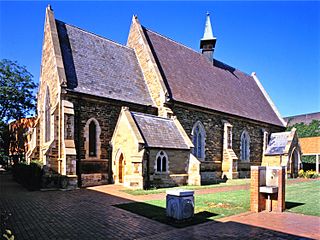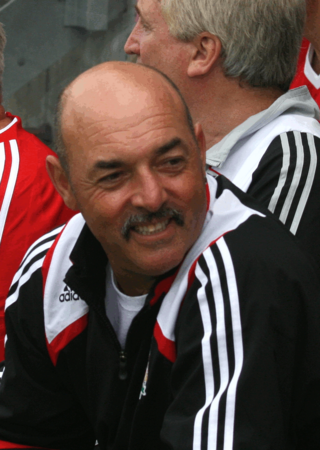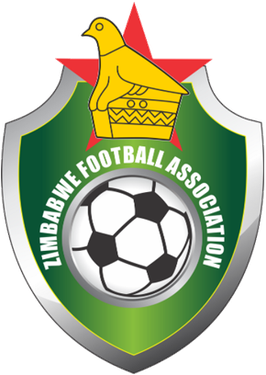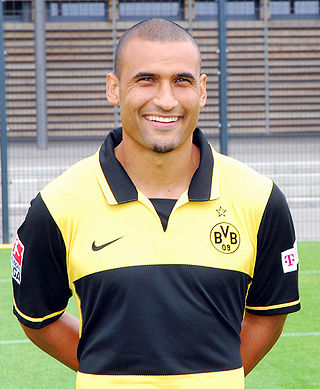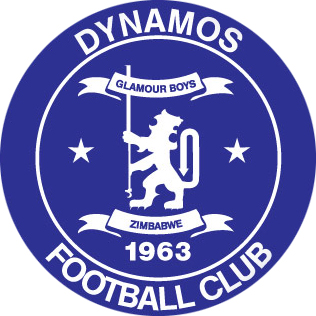Durban City
In early 1962, Chalmers moved with his new wife Audrey to the South African beach city of Durban, [1] where he gained a trial with Durban City of the all-white National Football League (SANFL), the first professional football league in South Africa. He impressed the coaches and signed on as a professional in April 1962. [7] Based at their New Kingsmead ground, Durban City had been formed in May 1959, [8] two months before the SANFL; [9] by 1962, they were one of the country's top teams, having won two of the first three national titles. A key player for the club during its early days was Les Salton, a South African forward who was the SANFL's top goalscorer in each of its first three seasons, netting 117 goals in all competitions, [8] including eight in one game against Johannesburg City in 1961. [4] [11] Chalmers joined just after Salton's sale to local rivals Durban United. [7]
Chalmers initially played as a winger, and scored 20 goals during his first professional season—15 in the league, and five more in cup competitions [4] —as his club finished third in the league, one point behind Highlands Park and Southern Suburbs, another club from Johannesburg. In the Castle Cup, Chalmers received his first winner's medal as part of the Durban City team which beat Johannesburg Ramblers 2–1 in the final at Rand Stadium on 20 October 1962. He started the following season on the wing, but was fielded as a centre forward for the first time in June 1963, when his club took on Kimberley United in a Castle Cup first-round tie. [1] The experiment proved a success, with Chalmers scoring seven in Durban City's 14–1 victory, latterly described by South African Soccer Weekly as a "massacre". [4] The following week, when he was retained as the team's front man for the home game against West Rand United, he scored a hat-trick. [1] He scored four more hat-tricks during the 1963 season, and finished the year with 26 league goals and nine more in other competitions. [4] Durban City once more finished third in the table.
During early 1964, Chalmers prepared thoroughly for the new season, seeking to broaden his style of play and remove some of the perceived technical weaknesses which observers thought had previously let him down; for example, before this time his heading skill had been seen as sub-par, and his passing skill had been little more than ordinary. When the season started, however, it quickly became evident to reporters that his hard work had paid off. In what is generally considered one of his strongest years as a professional, Chalmers progressed significantly during 1964, showing marked improvement in his heading, passing and shooting in particular. According to Byrom, Chalmers was during this period the best player in South Africa, "by far". [1] Alf Boyd, Durban City's Scottish manager, made Chalmers the team's permanent centre-forward seven games into the 1964 season. [1]
For me that game will always stand out. Hitting a brace against such stars was an awesome experience.
Chalmers remembers the Real Madrid match of 1964, speaking in 2009 [14]
Chalmers appeared in two friendly matches against touring teams during this year. First a combined team representing Natal Province lost 8–2 to English side Arsenal, then on 8 September 1964 Real Madrid took on a National Football League all-star team, dubbed the "Castle Knights", in front of 35,000 spectators at Rand Stadium. Byrom says the match was very exciting; "a wonderful soccer spectacle". [1] At half time the score was 3–0 to the visitors, but just after the interval Chalmers pulled one back, beating Uruguay international José Santamaría and another Madrid defender before slamming it into the away net. Santamaria reportedly stood stunned with his hands on his hips, not believing what had happened. [1] Jolted back to attention, the Spanish side rallied and scored twice more before Chalmers scored another "brilliant" [4] goal to make the score 5–2. Although he had finished on the losing side, Chalmers had acquitted himself well—the match is often cited as one of his best games. He was praised afterwards by Santamaria, who had been impressed by his speed and footballing instinct. [1] [4] [n 1]
Chalmers became one of the league's top forwards, in one match scoring three goals in four minutes against Arcadia Shepherds. In the Castle Cup, his goalscoring exploits consistently helped Durban City to progress. In the quarter-final, he scored what Byrom considers one of the best goals of his career, in a home match against rivals Durban United. United, with Salton leading their front line, scored twice in the first 13 minutes before City closed the gap to 2–1 a minute before the break. Early in the second half, Chalmers collected the ball near the edge of the penalty area and sprinted with it along the 18-yard line, prevented from moving forward by three pursuant United defenders. Chalmers then stopped abruptly and, as his opponents were caught off balance, fired a low shot past them into the net. [1]
City went on to win the match and eventually reach that year's final, against Jewish Guild at Rand Stadium on 10 October 1964. In front of 25,819 fans, the two teams were level at 1–1 before Chalmers scored a hat-trick during the second half to give his side a 4–1 victory. It was the Rhodesian's second cup medal, and the only time a hat-trick was scored in a Castle Cup final. [1] Also scoring freely in the league, Chalmers finished the season with 58 goals in all competitions (two short of Salton's South African record, set in 1960 [18] ), with 39 of them coming in the league's 32 games. [4] Durban City finished as league runners-up, three points behind Highlands Park, and reached the final of the Life Bowl, where they lost 2–1 to Durban United. The derby match, played at New Kingsmead, attracted 28,881 spectators, over 8,000 more than the previous year's final (in Johannesburg). [19] At the end of the season, Chalmers was named South African Footballer of the Year. [4]
In May 1965, soon into the new South African season, the Rhodesian Football Association's application for full membership in global football federation FIFA was approved, making it eligible to enter competitive international tournaments such as the World Cup for the first time (starting in 1970, as it was too late to enter qualifying for the 1966 tournament). [20] Chalmers scored 38 goals for Durban City during the 1965 season, including 22 in the league, [4] as the club finished third, 11 points behind first-placed Highlands Park. In the Life Bowl, City reached the final, which was played against Cape Town City at Cape Town's Hartleyvale Stadium. Chalmers scored two of his team's goals as Durban City finished 3–1 victors to win the cup for the second time. [19]
After Chalmers scored six goals for Durban City during the early part of the 1966 season, [4] the club sold him to Durban United for a South African record fee of R20,000. Although this record was later surpassed by transfer fees paid for South African-based players by foreign clubs, it remained the most expensive purchase by a South African club when the SANFL was dissolved in 1977. [3] Chalmers' final goalscoring tally for Durban City in all competitions was a club record 157—40 more than Salton. [22]

